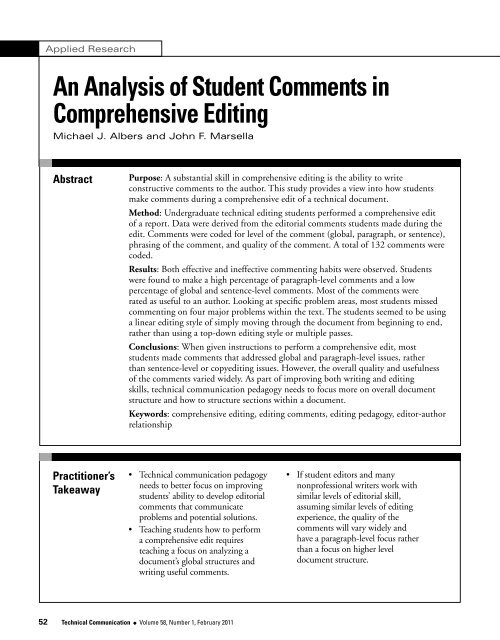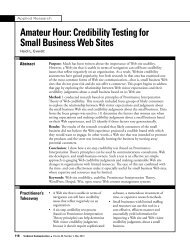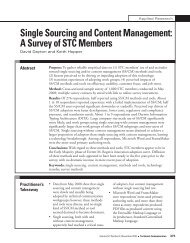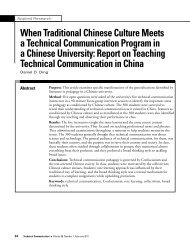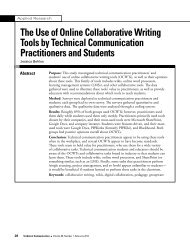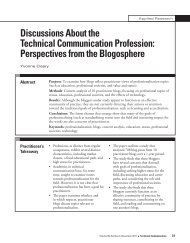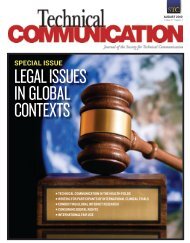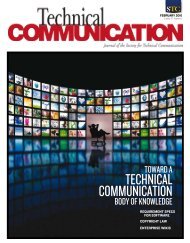An Analysis of Student Comments in Comprehensive Editing
An Analysis of Student Comments in Comprehensive Editing
An Analysis of Student Comments in Comprehensive Editing
Create successful ePaper yourself
Turn your PDF publications into a flip-book with our unique Google optimized e-Paper software.
Applied Research<strong>An</strong> <strong>An</strong>alysis <strong>of</strong> <strong>Student</strong> <strong>Comments</strong> <strong>in</strong><strong>Comprehensive</strong> Edit<strong>in</strong>gMichael J. Albers and John F. MarsellaAbstractPurpose: A substantial skill <strong>in</strong> comprehensive edit<strong>in</strong>g is the ability to writeconstructive comments to the author. This study provides a view <strong>in</strong>to how studentsmake comments dur<strong>in</strong>g a comprehensive edit <strong>of</strong> a technical document.Method: Undergraduate technical edit<strong>in</strong>g students performed a comprehensive edit<strong>of</strong> a report. Data were derived from the editorial comments students made dur<strong>in</strong>g theedit. <strong>Comments</strong> were coded for level <strong>of</strong> the comment (global, paragraph, or sentence),phras<strong>in</strong>g <strong>of</strong> the comment, and quality <strong>of</strong> the comment. A total <strong>of</strong> 132 comments werecoded.Results: Both effective and <strong>in</strong>effective comment<strong>in</strong>g habits were observed. <strong>Student</strong>swere found to make a high percentage <strong>of</strong> paragraph-level comments and a lowpercentage <strong>of</strong> global and sentence-level comments. Most <strong>of</strong> the comments wererated as useful to an author. Look<strong>in</strong>g at specific problem areas, most students missedcomment<strong>in</strong>g on four major problems with<strong>in</strong> the text. The students seemed to be us<strong>in</strong>ga l<strong>in</strong>ear edit<strong>in</strong>g style <strong>of</strong> simply mov<strong>in</strong>g through the document from beg<strong>in</strong>n<strong>in</strong>g to end,rather than us<strong>in</strong>g a top-down edit<strong>in</strong>g style or multiple passes.Conclusions: When given <strong>in</strong>structions to perform a comprehensive edit, moststudents made comments that addressed global and paragraph-level issues, ratherthan sentence-level or copyedit<strong>in</strong>g issues. However, the overall quality and usefulness<strong>of</strong> the comments varied widely. As part <strong>of</strong> improv<strong>in</strong>g both writ<strong>in</strong>g and edit<strong>in</strong>gskills, technical communication pedagogy needs to focus more on overall documentstructure and how to structure sections with<strong>in</strong> a document.Keywords: comprehensive edit<strong>in</strong>g, edit<strong>in</strong>g comments, edit<strong>in</strong>g pedagogy, editor-authorrelationshipPractitioner’sTakeaway• Technical communication pedagogyneeds to better focus on improv<strong>in</strong>gstudents’ ability to develop editorialcomments that communicateproblems and potential solutions.• Teach<strong>in</strong>g students how to performa comprehensive edit requiresteach<strong>in</strong>g a focus on analyz<strong>in</strong>g adocument’s global structures andwrit<strong>in</strong>g useful comments.• If student editors and manynonpr<strong>of</strong>essional writers work withsimilar levels <strong>of</strong> editorial skill,assum<strong>in</strong>g similar levels <strong>of</strong> edit<strong>in</strong>gexperience, the quality <strong>of</strong> thecomments will vary widely andhave a paragraph-level focus ratherthan a focus on higher leveldocument structure.52 Technical Communication l Volume 58, Number 1, February 2011
Applied ResearchAlbers and MarsellaIntroductionTechnical text creation occurs as a jo<strong>in</strong>t effort betweenthe writer and the editor, with the editor tasked withensur<strong>in</strong>g that the author’s text is “complete, accurate,correct, comprehensible, usable and appropriate forthe readers” and giv<strong>in</strong>g the writer “ways to make thedocument easier for readers to understand and use”(Rude, 2006, p. 12). Thus, we can, at a high level,def<strong>in</strong>e an editor’s job as ensur<strong>in</strong>g that the writer’s view<strong>of</strong> the content matches the reader’s view and the realisticcommunication uses <strong>of</strong> the text. Teach<strong>in</strong>g students howto edit <strong>in</strong> a manner that achieves this match requiresteach<strong>in</strong>g comprehensive edit<strong>in</strong>g. A substantial skill <strong>in</strong>comprehensive edit<strong>in</strong>g is the ability to write constructivecomments to the author. Although this is a valuable skill,there seems to be no research <strong>in</strong>to the type or quality<strong>of</strong> comments students actually make while perform<strong>in</strong>gcomprehensive edits. Without understand<strong>in</strong>g how theymake comments, we cannot know if we need to adjustpedagogy to improve their comment<strong>in</strong>g ability or whattype <strong>of</strong> changes may be required.The research may also provide a view <strong>in</strong>to howcomments are made on workplace documents bythe nontechnical editors review<strong>in</strong>g texts. In manyways, a technical review <strong>of</strong> a document acts as a form<strong>of</strong> comprehensive edit. <strong>Student</strong> editors and manynonpr<strong>of</strong>essional writers will be work<strong>in</strong>g with similarlevels <strong>of</strong> editorial skill. They have misconceptions aboutthe edit<strong>in</strong>g (or review) process and lack a full knowledge<strong>of</strong> the language to express their concerns. Eng<strong>in</strong>eers,programmers, and other nonpr<strong>of</strong>essional writers areconstantly tasked with review<strong>in</strong>g documents. Thequality <strong>of</strong> the review and comments varies, but I do notknow <strong>of</strong> any <strong>in</strong>-depth analysis <strong>of</strong> how they comment.This work could provide an <strong>in</strong>terest<strong>in</strong>g po<strong>in</strong>t <strong>of</strong>comparison between work<strong>in</strong>g pr<strong>of</strong>essionals and students.Literature Review“One <strong>of</strong> the most crucial tasks <strong>of</strong> the technicalcommunicator is to provide <strong>in</strong>formation that users needby carefully select<strong>in</strong>g the right mix <strong>of</strong> content and thendevelop<strong>in</strong>g, arrang<strong>in</strong>g, and present<strong>in</strong>g it effectively forthe audience” (Hayhoe, 2002, p. 398). Develop<strong>in</strong>ga text that provides that <strong>in</strong>formation <strong>in</strong> an effectivemanner <strong>of</strong>ten requires <strong>in</strong>teract<strong>in</strong>g with an editor whoworks at the comprehensive and organizational level. Forthe editor to be an effective member with<strong>in</strong> the writ<strong>in</strong>gprocess, those editorial comments need to writtensuch that the author can both understand them and bewill<strong>in</strong>g to act upon them (Albers, 2005). For example, <strong>in</strong>studies look<strong>in</strong>g at the <strong>in</strong>teraction <strong>of</strong> editors and s<strong>of</strong>twareeng<strong>in</strong>eers, Walkowski (1991) and W<strong>in</strong>sor (1993) bothfound that these s<strong>of</strong>tware eng<strong>in</strong>eers more than to havetheir work copyedited. They expect a comprehensiveedit with useful suggestions on how to improve theirtext, <strong>in</strong>clud<strong>in</strong>g ideas on how to reorganize it.Willen (2004) writes that “the primary objective <strong>of</strong>feedback is to help the writer develop a document thataddresses the needs and expectations <strong>of</strong> its audience”(p. 21). This goal is achieved when the editor not onlyrecognizes problems <strong>in</strong> a document, but also <strong>of</strong>ferssuggestions about how to correct them. Eaton Brewer,Portewig, and Davidson. (2008ab) highlight the needfor good-quality comments, s<strong>in</strong>ce they found thatabout 72 percent <strong>of</strong> comprehensive edit comments arefollowed. S<strong>in</strong>ce authors follow such a high percentage<strong>of</strong> comments, there is a substantial risk <strong>of</strong> poor-qualitycomments damag<strong>in</strong>g a document if the author bl<strong>in</strong>dlyfollows them. Poor-quality comments can also damagethe editor-author relationship by caus<strong>in</strong>g the author tolose respect for the editor.Ensur<strong>in</strong>g that the editor works well with the authorrequires that the editor make good comments. Not aparticularly easy task, s<strong>in</strong>ce as Lanier (2004) po<strong>in</strong>ts out,“authors may easily become <strong>of</strong>fended and feel that theyare be<strong>in</strong>g criticized rather than helped by the editors.Mak<strong>in</strong>g sure that authors are content with the edit<strong>in</strong>gprocess is important for establish<strong>in</strong>g a good collaborativerelationship” (p. 526). Multiple articles have <strong>of</strong>feredadvice on how to write those suggestions, although, withonly a few exceptions (primarily work by Eaton and hercolleagues), these studies provided m<strong>in</strong>imal empiricalevidence support<strong>in</strong>g their advice.<strong>Comments</strong> need to focus on improv<strong>in</strong>g the text tomeet the reader’s needs, and not personal preferences(Allen & Voss, 1998).<strong>Comments</strong> should be structured to <strong>in</strong>clude therational for the change: what is wrong with the text andwhat can be done to fix it (Gerich, 1994). Hart (2004)stresses us<strong>in</strong>g comments to clarify the nature <strong>of</strong> theedit, rather than simply chang<strong>in</strong>g text. Authors need aVolume 58, Number 1, February 2011 l Technical Communication 53
Applied Research<strong>An</strong> <strong>An</strong>alysis <strong>of</strong> <strong>Student</strong> <strong>Comments</strong> <strong>in</strong> <strong>Comprehensive</strong> Edit<strong>in</strong>g“pay<strong>of</strong>f statement” that expla<strong>in</strong>s why they should followthe suggestion, as opposed to just giv<strong>in</strong>g an editorialdirective (Eaton et al., 2008ab).• <strong>Comments</strong> need a context (Mackiewicz, 2005).Authors will <strong>in</strong>terpret them based on both word<strong>in</strong>g<strong>of</strong> the comment itself and how they see it fitt<strong>in</strong>gwith<strong>in</strong> the text. Perceptions <strong>of</strong> whether thecomment is useful or positive/negative are highlydependent on the context.• <strong>Comments</strong> should be phrased as suggestionsrather than directions to the author (Zimmerman& Taylor, 1999). As a limitation on their advice,Zimmerman and Taylor focus on copyedit<strong>in</strong>g ratherthan comprehensive edit<strong>in</strong>g, where a copyeditmark’s appropriateness tends to be more black andwhite than a comprehensive edit comment. On theother hand, non-native English-speak<strong>in</strong>g authorsseem to need directives rather than suggestionsbecause they experience problems pars<strong>in</strong>g asuggestion’s true underly<strong>in</strong>g <strong>in</strong>tent (Riley &Mackiewicz, 2003).• Authors prefer comments phrased as questionsrather than commands (Dragga & Gong 1989;Eaton, et al., 2008ab). However, Mackiewicz andRiley (2003) suggest us<strong>in</strong>g questions only when theeditor’s actual purpose is <strong>in</strong>quiry.• <strong>Comments</strong> should help ensure that the documentconforms to the house style, yet they must not doso at the expense <strong>of</strong> the author’s voice (Allen &Voss, 1998). Of course, with both the movementto highly collaborative group-written documentsand the movement toward dynamic text generationus<strong>in</strong>g technologies such as XML, the author’s voicemay have to be substantially modified to fit with therelated text by other authors (Albers, 2000).The preced<strong>in</strong>g list po<strong>in</strong>ts out that comments workbest as suggestions or questions, with an underly<strong>in</strong>gassumption that they are perceived as more politeand less demand<strong>in</strong>g. Although this question has beenexam<strong>in</strong>ed <strong>in</strong> the context <strong>of</strong> non-native English-speak<strong>in</strong>gauthors, work with native English-speak<strong>in</strong>g authorsis not as extensive (Eaton et al., 2008ab). Riley andMackiewicz (2003) say that directness is preferred topoliteness s<strong>in</strong>ce suggestions or questions make it harderfor non-native speaker to parse the editor’s <strong>in</strong>tent.<strong>Comments</strong> form a substantial factor <strong>in</strong>comprehensive edit<strong>in</strong>g, which tends to be describedas a multilevel process (<strong>An</strong>derson, Campbell, H<strong>in</strong>dle,Price, & Scasny, 1998; Buren & Fuehler, 1980). Edit<strong>in</strong>gtextbooks (Rude, 2005; Samson, 1993) suggest start<strong>in</strong>gat higher levels and work<strong>in</strong>g down; that is, the top-downedit<strong>in</strong>g style. The comprehensive editor must considernot only the document as a s<strong>in</strong>gle entity, but also thecoherence, structure, and style <strong>of</strong> lower levels, such asthe paragraph and sentence levels. <strong>An</strong> editor is expectedto identify any place with<strong>in</strong> a document where any <strong>of</strong>these writ<strong>in</strong>g elements break down and make commentsthat guide the author <strong>in</strong> fix<strong>in</strong>g the problems.A substantial part <strong>of</strong> comprehensive edit<strong>in</strong>g isprovid<strong>in</strong>g the author with a set <strong>of</strong> comments forimprov<strong>in</strong>g the text. The ability <strong>of</strong> editors to makeeffective comments will strongly <strong>in</strong>fluence the strength<strong>of</strong> the editor-writer relationship (Farkas & Poltrock,1995; Mackiewicz & Riley, 2003). Understand<strong>in</strong>g whyan editorial change was made or is be<strong>in</strong>g suggestedcan <strong>in</strong>crease the likelihood <strong>of</strong> the author accept<strong>in</strong>g thesuggestion. On the other hand, authors did not likeeditors who undertook to rewrite the text because “itsounds better” or who made edits that changed themean<strong>in</strong>g (Gerich, 1994). Thus, develop<strong>in</strong>g effectivecomment<strong>in</strong>g skills should be explicitly taught with<strong>in</strong> atechnical edit<strong>in</strong>g course.The need for good comments is addressed <strong>in</strong> everyedit<strong>in</strong>g textbook, but it is typically placed <strong>in</strong> terms <strong>of</strong>enhanc<strong>in</strong>g editor-author relationships, rather than <strong>in</strong>terms <strong>of</strong> produc<strong>in</strong>g quality comments. This creates aserious problem, as po<strong>in</strong>ted out by Grady, Mayweather,Davis, and LaPlume. (2004):Indeed, edit<strong>in</strong>g texts are full <strong>of</strong> <strong>in</strong>structions tostudents on how to foster good editor/authorrelationships. However, students <strong>of</strong>ten report theirsurprise at the difficulty <strong>of</strong> actually choos<strong>in</strong>g theright tone when writ<strong>in</strong>g and speak<strong>in</strong>g to authorsand how much they learn about the language<strong>of</strong> negotiation when conduct<strong>in</strong>g editor/authorconferences (p. 429).A question thus arises <strong>of</strong> how adept students are atmak<strong>in</strong>g comments as they perform a comprehensiveedit. Assum<strong>in</strong>g—as seems to be apparent from theliterature—that the ability to make comments is54 Technical Communication l Volume 58, Number 1, February 2011
Applied ResearchAlbers and Marsellavital for editors, technical edit<strong>in</strong>g courses need toexplicitly focus on teach<strong>in</strong>g this skill <strong>in</strong> both read<strong>in</strong>gand <strong>in</strong>-class discussions. As part <strong>of</strong> learn<strong>in</strong>g toperform a comprehensive edit, students need tolearn the follow<strong>in</strong>g:• How to make effective comments. The commentsneed to be diplomatic, provide adequate detail,and expla<strong>in</strong> the issue <strong>in</strong> enough depth to justify thesuggested change.• How to focus comments on the ma<strong>in</strong> problemswith<strong>in</strong> the text. <strong>Student</strong> editors need to learn tosee the higher level text problems and to clearlycommunicate those problems to an author.In this study, we <strong>in</strong>vestigate the comments madeby students dur<strong>in</strong>g a comprehensive edit. By identify<strong>in</strong>gthe type and quality <strong>of</strong> the comments, we have abasel<strong>in</strong>e on which to beg<strong>in</strong> understand<strong>in</strong>g how to betterteach comment<strong>in</strong>g <strong>in</strong> comprehensive edit<strong>in</strong>g. Explor<strong>in</strong>gthe typical edit<strong>in</strong>g difficulties students exhibit allowsus to suggest to technical edit<strong>in</strong>g <strong>in</strong>structors whichareas to concentrate on when teach<strong>in</strong>g comprehensiveedit<strong>in</strong>g skills.MethodsMaterialsThe assignment was to perform a comprehensiveedit <strong>of</strong> a seven-page Word document, which was arecommendation report compar<strong>in</strong>g two electricaleng<strong>in</strong>eer<strong>in</strong>g textbooks. The purpose <strong>of</strong> the report wasto enable a faculty committee to select a textbook for an<strong>in</strong>troduction to electrical eng<strong>in</strong>eer<strong>in</strong>g course. The textwas created by comb<strong>in</strong><strong>in</strong>g and rewrit<strong>in</strong>g reports createdfrom a student report assignment <strong>in</strong>to a s<strong>in</strong>gle report.The document had errors on all levels <strong>of</strong> structure.The text conta<strong>in</strong>ed copyedit-level errors (grammar andpunctuation errors) <strong>in</strong> number and type, which wereconsistent with a typical student-written paper. Thecoursework on comprehensive edit<strong>in</strong>g had stressedignor<strong>in</strong>g copyedit<strong>in</strong>g errors until the major structuralissues were fixed. <strong>Student</strong>s were not expected to performa copyedit as part <strong>of</strong> this study. Instead, they were told t<strong>of</strong>ocus the edit<strong>in</strong>g on improv<strong>in</strong>g the higher level problemswith the text.The samples for this study were collectedfrom the results <strong>of</strong> a graded comprehensive edit<strong>in</strong>gassignment that was adm<strong>in</strong>istered to 11 students <strong>in</strong> anundergraduate technical edit<strong>in</strong>g class. The assignmentwas completed by two students at a time <strong>in</strong> theresearcher’s <strong>of</strong>fice. The students worked separately ontwo computers us<strong>in</strong>g Micros<strong>of</strong>t Word XP on a standardlandscape-oriented monitor. There was a 45-m<strong>in</strong>utetime limit for complet<strong>in</strong>g the assignment. TechSmith’sMorae was used to create a screen video <strong>of</strong> the entireedit<strong>in</strong>g session. We acknowledge that the time limitposes a potential experimental confound and understandthat many editors would prefer to pr<strong>in</strong>t out the reportto read before edit<strong>in</strong>g it. However, we also acknowledgethe reality <strong>of</strong> how students tend to privilege f<strong>in</strong>ish<strong>in</strong>gan assignment over do<strong>in</strong>g it “by the book.” Most <strong>of</strong>the students completed the assignment before timeexpired, and none asked about pr<strong>in</strong>t<strong>in</strong>g it (a pr<strong>in</strong>ter wasavailable).All <strong>of</strong> the students were English majors, witha concentration <strong>in</strong> pr<strong>of</strong>essional and technicalcommunication. The edit<strong>in</strong>g class is structured as thesecond course <strong>in</strong> the concentration sequence. Althoughthe <strong>in</strong>troduction to technical communication course isnot a prerequisite, most <strong>of</strong> the students had completedit. The assignment was structured as a graded assignmentgiven at the end <strong>of</strong> the unit on comprehensive edit<strong>in</strong>g,which occurred about three quarters <strong>of</strong> the way throughthe semester. Previous class assignments <strong>in</strong>cluded both<strong>in</strong>-class and graded assignments on comprehensiveedit<strong>in</strong>g, which <strong>in</strong>cluded onl<strong>in</strong>e edit<strong>in</strong>g us<strong>in</strong>g Micros<strong>of</strong>tWord. None <strong>of</strong> the students exhibited any difficultieswith Word’s track changes and comments features.The University <strong>of</strong> Memphis Institutional ReviewBoard approved the study, and students signed theapproved release to use the assignment for researchpurposes.Cod<strong>in</strong>g the <strong>Comments</strong>The students’ comments were coded, but not their<strong>in</strong>l<strong>in</strong>e revisions to the text, s<strong>in</strong>ce the study’s purposewas to exam<strong>in</strong>e comments. Except for the studentswho attempted to rewrite the text, essentially all <strong>in</strong>l<strong>in</strong>erevisions were copyedits. The copyedit<strong>in</strong>g tended to bemark<strong>in</strong>g glar<strong>in</strong>g errors and did not capture the majority<strong>of</strong> the copyedit-level problems.Volume 58, Number 1, February 2011 l Technical Communication 55
Applied Research<strong>An</strong> <strong>An</strong>alysis <strong>of</strong> <strong>Student</strong> <strong>Comments</strong> <strong>in</strong> <strong>Comprehensive</strong> Edit<strong>in</strong>gThe cod<strong>in</strong>g schema was iteratively developed (Corb<strong>in</strong>& Strauss, 2007; Creswell, 2003). It was based on thethree levels <strong>of</strong> edits (global, paragraph, and sentence) andpossible comment types with<strong>in</strong> each level. The cod<strong>in</strong>gschema is described below. We started with a cod<strong>in</strong>gschema based on our expectations <strong>of</strong> what should bemarked <strong>in</strong> the text and through the iterative processdeveloped one that reflects actual student comments.Categories <strong>in</strong> which we expected to see comments but didnot do not appear <strong>in</strong> the f<strong>in</strong>al schema. In this study, wewere focused on what the students did comment on andnot what they missed. We do acknowledge that futurework needs to exam<strong>in</strong>e the types <strong>of</strong> edit<strong>in</strong>g issues studentstypically overlook.Two coders <strong>in</strong>dependently marked all <strong>of</strong> thecomments <strong>in</strong> the 11 samples. After the two coders had<strong>in</strong>dependently scored all the papers, they met, discussedtheir reason<strong>in</strong>g, and adjusted the cod<strong>in</strong>g so each paperhad one set <strong>of</strong> codes, which was used for the analysis.We def<strong>in</strong>ed a comment as a block <strong>of</strong> text relatedto a s<strong>in</strong>gle idea or concept. In some <strong>in</strong>stances a s<strong>in</strong>glecomment conta<strong>in</strong>ed multiple phrases or sentences. Tables1, 2, and 3 show example comments which we consideredone comment, although many have multiple sentences. Intwo cases, the editor used one Word comment “bubble”to house more than one comment. In these cases, eachcomment was coded <strong>in</strong>dependently.The cod<strong>in</strong>g schema analyzed three factors. Eachcomment was coded for three different attributes.• Level <strong>of</strong> structure commented on (global, paragraph,or sentence)• Type <strong>of</strong> comment (direct or <strong>in</strong>direct)• Quality <strong>of</strong> comment (good or poor)Besides cod<strong>in</strong>g the edited document, we reviewedthe Morae record<strong>in</strong>gs for each subject. The video was notcoded, but was used as support for the f<strong>in</strong>d<strong>in</strong>gs on thecomments. Our <strong>in</strong>itial review <strong>of</strong> the Morae record<strong>in</strong>gsfound few actions specifically associated with mak<strong>in</strong>gspecific comments, such as scroll<strong>in</strong>g up/down beforemak<strong>in</strong>g the comment. The record<strong>in</strong>gs could have beenuseful for an overall analysis <strong>of</strong> how students approachedit<strong>in</strong>g, but that was outside the study’s scope.With<strong>in</strong> each <strong>of</strong> the attributes, the follow<strong>in</strong>g set <strong>of</strong>codes was used.Level <strong>of</strong> Comment Based on a top-down edit<strong>in</strong>gstructure (Rude, 2005; Samson, 1993), the commentswere coded based on the level <strong>of</strong> change they reflected:global, paragraph, or sentence. With<strong>in</strong> each <strong>of</strong> these threegroups, the specific type <strong>of</strong> comment was also coded.Tables 1–3 show examples <strong>of</strong> each type <strong>of</strong> cod<strong>in</strong>g.GlobalWhole documentSection levelGlobal wordchoiceParagraphNeed for specificcontentRevis<strong>in</strong>g contentOrder <strong>of</strong><strong>in</strong>formationFormat and designPresentationSuggestions on document-wideconsistency, structural,or organizational issues.Suggestions on section-wideconsistency, structural, ororganizational issues.Suggestions on word<strong>in</strong>gproblems that needed to beaddressed throughout thedocument.Suggestions that po<strong>in</strong>tedout that specific contenteither is miss<strong>in</strong>g or should beadded to better develop theargument.Suggestions that assumedthe content was present butneeded to be reworked. Theeditor may be po<strong>in</strong>t<strong>in</strong>g outredundant <strong>in</strong>formation orask<strong>in</strong>g for justification onthe <strong>in</strong>clusion <strong>of</strong> the content <strong>in</strong>question.Suggestions that addressedthe order <strong>of</strong> <strong>in</strong>formationwith<strong>in</strong> paragraphs.Suggestions that addressedthe proper use <strong>of</strong> subhead<strong>in</strong>gsor <strong>in</strong>dicated <strong>in</strong>consistentformatt<strong>in</strong>g structure.Suggestions that addressedthe way <strong>in</strong>formation waspresented: the editor suggests<strong>in</strong>formation delivery via lists,figures, and tables.56 Technical Communication l Volume 58, Number 1, February 2011
Applied ResearchAlbers and MarsellaDeletionSentenceMean<strong>in</strong>g andclarityGrammaticalRevision <strong>of</strong>sentenceWord changeDeletionSuggestions thatrecommended the deletion<strong>of</strong> partial or even entireparagraphs ow<strong>in</strong>g to needlessor redundant <strong>in</strong>formation.Suggestions that asked fora revision <strong>of</strong> the sentencefor clarity or mean<strong>in</strong>g. Theeditor may <strong>in</strong>dicate the needfor more <strong>in</strong>formation <strong>in</strong>order to have the sentencemake sense <strong>in</strong> the context <strong>of</strong>the paragraph.Suggestions that askedfor grammatical andmechanical changes, such aspunctuation issues, subjectverbagreement, or run-onsentences.Suggestions that askedfor a rewrite <strong>of</strong> an entiresentence, which <strong>of</strong>tenstemmed from poor flow orimprecise word<strong>in</strong>g. Sentencerevision comments differfrom mean<strong>in</strong>g and claritycomments <strong>in</strong> that suggestionsfor revision tend to deal morewith stylistic issues.Suggestions that asked forword changes. The authormay have used a word<strong>in</strong>correctly or imprecisely.Suggestions that ask fordelet<strong>in</strong>g an entire sentence.This normally occurs whenthe sentence is redundant orunnecessary.Type <strong>of</strong> CommentThe phras<strong>in</strong>g <strong>of</strong> the comment can affect how theauthor perceives it and how it <strong>in</strong>fluences the editorauthorrelationship (Dragga & Gong 1989; Eaton etal., 2008ab; Riley & Mackiewicz, 2003; Zimmerman& Taylor, 1999). The comments were coded as director <strong>in</strong>direct, with subclassifications that reflect thecomment’s content.Direct <strong>Comments</strong>QuestionDirectiveCommentExpla<strong>in</strong><strong>in</strong>g editIndirect <strong>Comments</strong>Directive asquestionDirective ascommentPhrased as a question toask the author’s <strong>in</strong>tentionor solicits justification <strong>of</strong>the text.Phrased to openly expressthe editor’s <strong>in</strong>tent and <strong>of</strong>fersdirect editorial observation.It <strong>in</strong>structs the author tomake specific changes tothe document.Phrased to have noimplication regard<strong>in</strong>g arevision to the text. Forexample, the editor maybe simply stat<strong>in</strong>g that thesentence or paragraph iswell written.Phrased as a justificationor rationalization <strong>of</strong> aneditorial change.Phrased <strong>in</strong> an <strong>in</strong>terrogativefashion, although the <strong>in</strong>tentand tone is that the authorshould make the change.Phrased as a superficially<strong>of</strong>fhanded comment aboutthe text, but with an <strong>in</strong>tentand tone that the authorshould make the change.Quality <strong>of</strong> Comment<strong>Comments</strong> were coded as either good or poor basedon how understandable or usable they were withrespect to mak<strong>in</strong>g text changes. As Willen (2004)mentions, editorial quality rests with the editor’s abilityto recognize problems and make clear, understandablesuggestions for revisions. In many <strong>in</strong>stances, thedifference between a good comment and a poor onewas a matter <strong>of</strong> clarity; <strong>in</strong> other <strong>in</strong>stances, it was theVolume 58, Number 1, February 2011 l Technical Communication 57
Applied Research<strong>An</strong> <strong>An</strong>alysis <strong>of</strong> <strong>Student</strong> <strong>Comments</strong> <strong>in</strong> <strong>Comprehensive</strong> Edit<strong>in</strong>geditor’s skills (or lack there<strong>of</strong>) at identify<strong>in</strong>g andexpla<strong>in</strong><strong>in</strong>g problems.For this cod<strong>in</strong>g, comment quality was a b<strong>in</strong>aryassessment: good or poor.Good Clear, direct, and, if followed, shouldproduce positive results for the document.Poor Muddled, unnecessary, or <strong>in</strong>effectual; a poorcomment will not benefit the document andmay <strong>in</strong> some cases degrade the quality <strong>of</strong> thedocument if followed. A poor comment wasnot always a wrong or misplaced comment,but the word<strong>in</strong>g was not sufficient orappropriate for a writer to effectivelyact upon it.We acknowledge that a f<strong>in</strong>er gra<strong>in</strong>ed evaluation <strong>of</strong>the comment quality would have been preferable; butfor this exploratory study, the comments did not lendthemselves to a f<strong>in</strong>er gra<strong>in</strong>ed cod<strong>in</strong>g. In addition, thef<strong>in</strong>al metric <strong>of</strong> comment quality would be how well ithelps an author modify the text. S<strong>in</strong>ce this an edit<strong>in</strong>gexercise and the edits were not returned to an author, wewere not able to make that judgment. Instead, as coders,we had to make that judgment for an imag<strong>in</strong>ed author.F<strong>in</strong>ally, we were more concerned with the poor/notpoor split. That judgment was easier to make s<strong>in</strong>ce thepoor comments tended to have little usable content. Forexample, if the comment said “this paragraph is vague,”how was an author suppose to revise the paragraph whennoth<strong>in</strong>g expla<strong>in</strong>s what aspects are vague?ResultsAmong the 11 sample assignments, 132 commentswere made. N<strong>in</strong>e students f<strong>in</strong>ished the assignmentto their satisfaction with<strong>in</strong> the 45-m<strong>in</strong>ute time limit.Two students took a more heavy-handed approach andattempted to rewrite the document <strong>in</strong>stead <strong>of</strong> <strong>of</strong>fer<strong>in</strong>gsuggestions to the authors. As a result, they only workedwith the first 25% to 30% <strong>of</strong> the document before theend <strong>of</strong> the 45 m<strong>in</strong>utes.The number <strong>of</strong> comments per person ranged from 3to 23. The lowest three (3, 4, and 6 comments) <strong>in</strong>cludedthe two students who rewrote the text rather, and onewho made mostly s<strong>in</strong>gle-word changes with<strong>in</strong> the text.After these three students, the number <strong>of</strong> commentsjumped to a range <strong>of</strong> 10–23, with 6 <strong>of</strong> the 11 studentsmak<strong>in</strong>g 10–16 comments.We did not test for statistical significance because<strong>of</strong> the small number <strong>of</strong> subjects. Instead, we tied thecod<strong>in</strong>g back to specific edit<strong>in</strong>g examples to help revealsome specific problems that should be directly addressed<strong>in</strong> teach<strong>in</strong>g comprehensive edit<strong>in</strong>g.“How to edit” articles and textbooks typically adviseread<strong>in</strong>g over the entire document before mak<strong>in</strong>g anyedit marks. In this study, five <strong>of</strong> the 11 students lookedthrough the document first; however, four <strong>of</strong> those fivespent only one to two m<strong>in</strong>utes look<strong>in</strong>g over the text.Obviously, this means they could not have accomplishedmore than briefly skimm<strong>in</strong>g it. One student spentalmost five m<strong>in</strong>utes read<strong>in</strong>g the text. Three students(<strong>in</strong>clud<strong>in</strong>g the two who did a rewrite rather than an edit)used a very l<strong>in</strong>ear edit<strong>in</strong>g style that started at the top <strong>of</strong>the document and moved down with m<strong>in</strong>imal scroll<strong>in</strong>g.The other students scrolled up and down many times,obviously compar<strong>in</strong>g between sections, before mak<strong>in</strong>gcomments. On the other hand, all students edited thedocument <strong>in</strong> a s<strong>in</strong>gle pass; no one used the approachadvocated by edit<strong>in</strong>g articles and discussed <strong>in</strong> class <strong>of</strong>perform<strong>in</strong>g multiple passes through the document andlook<strong>in</strong>g for specific items on each pass.The Morae videos showed that most students werescroll<strong>in</strong>g up and down throughout the edit<strong>in</strong>g process,so we assume they were work<strong>in</strong>g to ma<strong>in</strong>ta<strong>in</strong> a mentalimage <strong>of</strong> the overall context <strong>of</strong> the specific paragraphthey were edit<strong>in</strong>g.Summary <strong>of</strong> the Cod<strong>in</strong>gOf the 132 comments collected, the global level wasthe least commented on: only 11 comments (8%) weremade on this level (Figure 1). Paragraph-level commentswere the predom<strong>in</strong>ant level, with 81 comments (62%).There were 40 sentence-level comments (30%).Global Level Six students (54%) made at leastone global comment (maximum was three comments),for a total <strong>of</strong> 11 global comments (Figure 2). With<strong>in</strong>the global level, eight comments address section-levelissues (Table 1). Although the number <strong>of</strong> section-levelcomments looks encourag<strong>in</strong>g, half <strong>of</strong> them identified theneed to expand the conclusion.58 Technical Communication l Volume 58, Number 1, February 2011
Applied ResearchAlbers and MarsellaExclud<strong>in</strong>g the global comments about theconclusion, there was no consistent placement <strong>of</strong> globalcomments with<strong>in</strong> the text. Some <strong>of</strong> the comments,while global, tended to not provide usable guidance. Forexample, “Introduction is vague. Be more specific,” tellsthe author the <strong>in</strong>troduction is vague without provid<strong>in</strong>gany feedback on why the editor feels it is vague or howto improve it.Paragraph Level More than half the commentswere paragraph-level comments. The breakdown by typeis shown <strong>in</strong> Figure 3. Of the 68 paragraph comments,53 directly addressed content or presentation (Table 2).Figure 1. <strong>Comments</strong> by levelFigure 2. Global-level comments by typeSentence Level More than half <strong>of</strong> the sentence-levelcomments dealt with sentence mean<strong>in</strong>g (14 times) orasked for a rewrite to make the content clearer (9 times)(Figure 4). Table 3 shows that grammar was called <strong>in</strong>toquestion onlyonce, word choice 10 times, and sentence rewrites 9times. This puts half <strong>of</strong> the sentence level edits at thecopyedit level.In general, based on the ratios <strong>of</strong> paragraph-tosentence-leveledits and the extent <strong>of</strong> comprehensivesentence-level edits, the students clearly rema<strong>in</strong>edfocused on comprehensive edit<strong>in</strong>g issues and avoidedsimply perform<strong>in</strong>g a copyedit. On the other hand,because copyedit<strong>in</strong>g revisions were made <strong>in</strong>-l<strong>in</strong>e withthe text and this study looked only at the comments,copyedits were not analyzed as part <strong>of</strong> the cod<strong>in</strong>g.Type <strong>of</strong> Comment Hart (2005) writes that “thegoal [<strong>of</strong> edit<strong>in</strong>g] is to constantly re<strong>in</strong>force the notionthat [the editor is] propos<strong>in</strong>g rather than demand<strong>in</strong>gchanges” (p. 27). Mackiewicz and Riley (2003) discussthe importance <strong>of</strong> politeness and also mention that<strong>in</strong>direct comments are typically perceived as more polite.The comment’s tone can determ<strong>in</strong>e the author’s op<strong>in</strong>ion<strong>of</strong> the editor: One harsh-sound<strong>in</strong>g comment couldcause the author to ignore the editor’s work wholesale.Editorial comments can be divided <strong>in</strong>to two ma<strong>in</strong> types:direct comments and <strong>in</strong>direct comments. With directcomments, the editor is direct<strong>in</strong>g the author to make arevision, while with <strong>in</strong>direct comments, a more passiveapproach is used, with the <strong>in</strong>tent that the author willmake revisions as the editor <strong>in</strong>tended.Volume 58, Number 1, February 2011 l Technical Communication 59
Applied Research<strong>An</strong> <strong>An</strong>alysis <strong>of</strong> <strong>Student</strong> <strong>Comments</strong> <strong>in</strong> <strong>Comprehensive</strong> Edit<strong>in</strong>gDirect comments made up 99 (75%) <strong>of</strong> the 132comments (Table 4). Of those, 19 comments wereposed as questions. Editors used <strong>in</strong>direct comments <strong>in</strong>33 <strong>in</strong>stances. Most students made at least one <strong>in</strong>directcomment; typically 10%-30% <strong>of</strong> the comments by eachstudent were <strong>in</strong>direct. Explanations <strong>of</strong> edits occurredonly 12 times. It seems that students consideredtheir edits to be self-explanatory and not requir<strong>in</strong>gjustification. Most edit explanations were justify<strong>in</strong>gdeletions or word changes.Quality <strong>of</strong> <strong>Comments</strong> Poor comments tended tobe <strong>of</strong> m<strong>in</strong>imal use to an author need<strong>in</strong>g <strong>in</strong>formationabout what to actually change, such as “repetitious” and“beg<strong>in</strong> under Criteria.” They also <strong>in</strong>cluded page layoutcomments that were not appropriate at this stage <strong>of</strong>edit<strong>in</strong>g, such as po<strong>in</strong>t<strong>in</strong>g out orphaned sentences.A few students made most <strong>of</strong> the poor-qualitycomments (24 total) (Table 5). Three students madea total <strong>of</strong> 14 comments rated as poor. The studentby-studentbreakdown for those three is as follows: 5comments with 4 rated as poor, 10 comments with 5rated as poor, and 16 comments with 5 rated as poor.Figure 3. Paragraph-level comments by typeTable 1. Global-level comment examplesComment type Number ExamplesSection level 8 • Give an Executive Summary <strong>of</strong> the analysis.• After the chart, you need to write a brief conclusion and give arecommendation. Sum up all the <strong>in</strong>formation that you just presented<strong>in</strong> the chart.Whole document 2 • You were too passive <strong>in</strong> your analyses <strong>of</strong> this book. Consider go<strong>in</strong>g back andbe<strong>in</strong>g fair and concise <strong>in</strong> your evaluation.Global word choice 1 • You need to stay <strong>in</strong> the same tense. Is it past or present?60 Technical Communication l Volume 58, Number 1, February 2011
Applied ResearchAlbers and MarsellaAlso, the two students who did a rewrite had a total <strong>of</strong>seven comments, with five rated as poor.Figure 4. Sentence-level comments by typeTable 2. Paragraph-level comment examplesIdentify<strong>in</strong>g Major Problem AreasIt appears that most <strong>of</strong> the students grasped the basicconcept <strong>of</strong> how to perform a comprehensive edit andcan make solid, constructive comments. Ignor<strong>in</strong>gthe students who tried to rewrite rather than editthe text, we found that most <strong>of</strong> the others produceda consistently high number <strong>of</strong> comments that werebasically <strong>of</strong> good quality.However, <strong>in</strong> addition to the ability to constructgood comments, learn<strong>in</strong>g to edit <strong>in</strong>cludes develop<strong>in</strong>gthe ability to spot major problems with<strong>in</strong> the text.A group <strong>of</strong> editors work<strong>in</strong>g on the same documentshould produce a relatively consistent set <strong>of</strong> edits. Atthe very least, most (if not all) <strong>of</strong> the major problemswith<strong>in</strong> the document should be marked. That situation,however, was not evidenced <strong>in</strong> this study. In review<strong>in</strong>gComment type Number ExamplesNecessary content 21 • List the criteria. Why make the reader wait?• This topic was not mentioned <strong>in</strong> your <strong>in</strong>troduction at all. Either <strong>in</strong>sert it<strong>in</strong>to the <strong>in</strong>troduction or delete it.Content 15 • This is a lot <strong>of</strong> <strong>in</strong>formation to put <strong>in</strong>to this report. Is this necessary foryour audience?• Your language turns toward a lay audience <strong>in</strong> this paragraph. Consideradd<strong>in</strong>g more <strong>in</strong>formation about the book <strong>in</strong>stead <strong>of</strong> mak<strong>in</strong>g it so passive.Format 3 • Use subhead<strong>in</strong>gs for each <strong>of</strong> the books.• Make white space between level 1 titles and the previous text smaller.Order <strong>of</strong> <strong>in</strong>formation 17 • Organization and layout should be first as it is <strong>in</strong> the evaluation section.• It seems more logical to discuss the chapter beg<strong>in</strong>n<strong>in</strong>g before the end.• Should this paragraph be made to fit <strong>in</strong> the first paragraph?Presentation <strong>of</strong> <strong>in</strong>formation 18 • I would suggest a list.• You could also use a table to address some form <strong>of</strong> organization criteria.Delete paragraph 7 • I would assume that the only people who would be read<strong>in</strong>g this analysisare the college faculty and staff members. They know the process theygo through every year. Just get straight to your evaluation.• This section should be deleted s<strong>in</strong>ce it isn’t necessary and does notfollow the report format.Volume 58, Number 1, February 2011 l Technical Communication 61
Applied Research<strong>An</strong> <strong>An</strong>alysis <strong>of</strong> <strong>Student</strong> <strong>Comments</strong> <strong>in</strong> <strong>Comprehensive</strong> Edit<strong>in</strong>gthe comments, a lack <strong>of</strong> consistency <strong>in</strong> po<strong>in</strong>t<strong>in</strong>g outsignificant problems was noted. The specific problemsfound tended to not be the major problems, but rather arandom collection <strong>of</strong> problems, which varied by student.To explore this further, we exam<strong>in</strong>ed the commentsmade about four significant problem areas (Table 6).In general, most <strong>of</strong> the students missed any onespecific problem. Fewer than half the students noticedeach <strong>of</strong> these major problems with<strong>in</strong> the text. Onestudent noticed all four problems, and three othersnoticed three problems (<strong>in</strong>terest<strong>in</strong>gly, these three allmissed the Equivalent Circuit section problem).DiscussionThe results <strong>of</strong> the study have significance for teach<strong>in</strong>gthe comprehensive edit<strong>in</strong>g segments <strong>of</strong> a technicaledit<strong>in</strong>g course.We, as technical edit<strong>in</strong>g <strong>in</strong>structors, must directstudents toward effective edit<strong>in</strong>g habits, such as a topdownedit<strong>in</strong>g style. The lack <strong>of</strong> global-level comments,when coupled with the failure to ga<strong>in</strong> an overview <strong>of</strong>the document before beg<strong>in</strong>n<strong>in</strong>g to edit, may reveal thatthey are not us<strong>in</strong>g a top-down edit<strong>in</strong>g style. Instead,students seem to be us<strong>in</strong>g a l<strong>in</strong>ear edit<strong>in</strong>g style <strong>of</strong>simply mov<strong>in</strong>g through the document from beg<strong>in</strong>n<strong>in</strong>gto end. Additional support for that assumption camefrom the Morae video, which showed that only onestudent reviewed the entire document before start<strong>in</strong>gto edit. The others all started read<strong>in</strong>g/edit<strong>in</strong>g from thebeg<strong>in</strong>n<strong>in</strong>g without ga<strong>in</strong><strong>in</strong>g an understand<strong>in</strong>g <strong>of</strong> whatthe document conta<strong>in</strong>ed. Granted, top-down edit<strong>in</strong>gis covered <strong>in</strong> essentially all edit<strong>in</strong>g classes, but perhapsthe discussion can be comb<strong>in</strong>ed with work<strong>in</strong>g throughspecific global-level examples to help the studentscontextualize its advantages.It appears from the l<strong>in</strong>ear edit<strong>in</strong>g style and the factthat the majority <strong>of</strong> comments were at the paragraphlevel that the students focus on work<strong>in</strong>g with the text atthe paragraph level rather than consider<strong>in</strong>g how thoseparagraphs fit together with<strong>in</strong> a section or a document.A possible explanation is that students have had m<strong>in</strong>imalexposure to writ<strong>in</strong>g text that is divided <strong>in</strong>to sections.Table 3. Sentence-level comment examplesComment type Number ExampleMean<strong>in</strong>g\clarity 14 • Not def<strong>in</strong>ed—should be def<strong>in</strong>ed <strong>in</strong> the second sentence if us<strong>in</strong>g theacronym.• Why was this a disadvantage?Grammar 1 • Should circuits be plural here?Rewrite 9 • Too many sentences are beg<strong>in</strong>n<strong>in</strong>g with “the book.”• This phrase sort <strong>of</strong> belittles the reader.• You should reword this sentence. It is unclear whether you mean the lack<strong>of</strong> important concepts was a disadvantage or the lack <strong>of</strong> color conceptswas a disadvantage.Word choice 10 • Be consistent. In the first paragraph you were specific about whichcircuit course.• You should avoid us<strong>in</strong>g the word “good” s<strong>in</strong>ce it is too vague.Delete sentence 6 • The background <strong>in</strong>formation is unnecessary.• This sentence should not be here because organization and layout arenot discussed <strong>in</strong> this paragraph.62 Technical Communication l Volume 58, Number 1, February 2011
Applied ResearchAlbers and MarsellaAlmost all <strong>of</strong> their academic writ<strong>in</strong>g has been long proseparagraphs <strong>in</strong> texts with no head<strong>in</strong>gs, <strong>of</strong>ten composed<strong>in</strong> a s<strong>in</strong>gle (or m<strong>in</strong>imal number <strong>of</strong>) draft(s). In addition,students typically have not seen real edited documents.Their worldview <strong>of</strong> comments is the comments we, as<strong>in</strong>structors, make on their papers. Unfortunately, from atechnical edit<strong>in</strong>g viewpo<strong>in</strong>t, academic paper commentsand technical editor comments are very different. Early<strong>in</strong> the semester, it may be worthwhile to discuss thisdifference <strong>in</strong> writ<strong>in</strong>g comments, expla<strong>in</strong> the reason<strong>in</strong>g,and specifically po<strong>in</strong>t out how the goals <strong>of</strong> grad<strong>in</strong>g astudent paper and edit<strong>in</strong>g a technical document differ.A significant area <strong>of</strong> concern is the failure toconsistently identify the major problems with<strong>in</strong> theTable 4. Type <strong>of</strong> comment examplesComment type Number ExampleDirect comment:DirectiveDirect comment:QuestionDirect comment:CommentDirect comment:Expla<strong>in</strong><strong>in</strong>g editIndirect comment:Directive as questionIndirect comment:Directive as comment64 • Insert a bulleted list <strong>of</strong> your criteria here.• Make white space between level 1 titles and the previous text smaller.19 • There is not enough <strong>in</strong>formation given about the background. Why arethese the chosen books to be evaluated?• How is the complexity reasonable for the students? Are the students ableto follow the material with understand<strong>in</strong>g?4 • These criteria for figures are not always covered exactly <strong>in</strong> evaluation.• The follow<strong>in</strong>g paragraphs are just restat<strong>in</strong>g the tables.12 • This is already stated <strong>in</strong> the <strong>in</strong>troduction paragraph.• The word “problems” is ambiguous. You should use “exercises” to makeyour mean<strong>in</strong>g more specific.5 • Shouldn’t this paragraph be <strong>in</strong> the criteria section?• Should this paragraph be made to fit <strong>in</strong> the first paragraph?28 • This sentence should not be here because organization and layout arenot discussed <strong>in</strong> this paragraph.• A teacher for this course should know this already. It seems like you’retalk<strong>in</strong>g down.Table 5. Quality <strong>of</strong> comment examplesComment type Number ExampleGood quality 108 • The comments given as examples <strong>in</strong> tables 1, 2, and 3 <strong>of</strong> this article wereall rated as good quality.Poor quality 24 • Repeats first paragraph.• Not needed.• Move this section up to the previous page.• Need stronger conclusion than tables.Volume 58, Number 1, February 2011 l Technical Communication 63
Applied Research<strong>An</strong> <strong>An</strong>alysis <strong>of</strong> <strong>Student</strong> <strong>Comments</strong> <strong>in</strong> <strong>Comprehensive</strong> Edit<strong>in</strong>gtext. Fix<strong>in</strong>g many <strong>of</strong> the problems identified <strong>in</strong> thestudents’ comments would not significantly improve thedocument’s ability to communicate <strong>in</strong>formation. Willen(2004) suggests teach<strong>in</strong>g guidel<strong>in</strong>es for comment<strong>in</strong>gto technical communication students, and that aspecific protocol should be <strong>in</strong>troduced so that they cancomment effectively and with purpose. Also, it is hardto write or teach a guidel<strong>in</strong>e that addresses global-levelissues without either be<strong>in</strong>g too vague to be practical(such as “ensure that the sections form a coherentwhole”) or be<strong>in</strong>g written for a specific document typeand context (proposals for company X). Use <strong>of</strong> edit<strong>in</strong>gchecklists may help, although typically checklists seemto be used as a “have I done everyth<strong>in</strong>g” referenceconsulted at the end <strong>of</strong> the edit<strong>in</strong>g project. More thanteach<strong>in</strong>g students to follow a checklist, course pedagogyneeds to help the students <strong>in</strong>ternalize what wouldappear on a checklist. This is an <strong>in</strong>terest<strong>in</strong>g catch-22 forteach<strong>in</strong>g, s<strong>in</strong>ce help<strong>in</strong>g students <strong>in</strong>ternalize a checklistTable 6. Consistency <strong>of</strong> identify<strong>in</strong>g problem areasProblem areaLists and graphics(The text had no lists or graphics. Much<strong>of</strong> the analysis lent itself to bullet listsand summary tables. Also, the quality<strong>of</strong> the book’s graphics were mentioned,but examples were not given.)Evaluation Criteria section(This section was written as a s<strong>in</strong>glelong paragraph conta<strong>in</strong><strong>in</strong>g multipletopics.)Equivalent Circuit section(Other sections evaluated each book<strong>in</strong> a separate paragraph; this sectioncomb<strong>in</strong>ed the evaluation <strong>in</strong>to one paragraph.)Conclusion(Conclusion was two tables, with noparagraphs <strong>in</strong>terpret<strong>in</strong>g the tables andrecommendation.)<strong>Student</strong>s whocommented5435requires repetition and work<strong>in</strong>g <strong>in</strong> class with documentslong enough to conta<strong>in</strong> global issues. Yet limited classtime severely restricts students from work<strong>in</strong>g withdocuments <strong>of</strong> sufficient length.Classroom ImplicationsThe student editors seem to have a grasp <strong>of</strong> paragraphlevelskills; Figure 3 shows that more than half <strong>of</strong> thecomments dealt with content issues. Based on thisfactor, students seem to be able to evaluate contentat the paragraph level, but not at a higher level. Thestudents created comments aimed at the paragraphlevel, rather than creat<strong>in</strong>g comments that addressed thehigher levels <strong>of</strong> the text and plac<strong>in</strong>g those comments<strong>in</strong>to the context <strong>of</strong> the overall text. Or perhaps theyhad noticed the section-level problem, but had wordedthe edit<strong>in</strong>g comments at the lower level <strong>of</strong> giv<strong>in</strong>g direct“fix this” comments. This study was unable to discernthe mental processes and logic the students used whendecid<strong>in</strong>g to write a comment. Discussions <strong>in</strong> which theyhave to justify why the comment was written as it wascould prove beneficial, s<strong>in</strong>ce they would expose how thestudent was actually see<strong>in</strong>g the problem. Editors andwriters both need to understand the more general textproblems, rather than just give or receive specific “fixit” comments. Unless the comment <strong>in</strong>spires the writerto see the bigger problem, the writer might not see therelevance <strong>of</strong> the comment.Bereiter and Scardamalia (1987) po<strong>in</strong>t out thatcompos<strong>in</strong>g pushes the writer almost to the po<strong>in</strong>t <strong>of</strong>cognitive overload. We have no doubt (although thisstudy did not measure it) that editors also work veryclose to cognitive overload. If the students sufferedcognitive overload, it would have led to tasks be<strong>in</strong>gdropped—reduc<strong>in</strong>g the scope <strong>of</strong> problems looked for—and lowered edit<strong>in</strong>g quality. Emphasiz<strong>in</strong>g the need formultiple passes through a document (which none <strong>of</strong> thestudents did) should reduce overall cognitive workload.At some level, the lack <strong>of</strong> multiple passes may be relatedto students’ develop<strong>in</strong>g edit<strong>in</strong>g skills. Just as a beg<strong>in</strong>n<strong>in</strong>gwriter tries to write a s<strong>in</strong>gle draft document, onlyexperienced editors and writers understand the needfor multiple drafts. Stress<strong>in</strong>g multiple-pass edit<strong>in</strong>g forclass assignments should also help address the problem<strong>of</strong> lack <strong>of</strong> consistency. With an edit pass focused on asmaller set <strong>of</strong> edits, the student should be able to spotproblems more easily. How to teach multipass edit<strong>in</strong>g64 Technical Communication l Volume 58, Number 1, February 2011
Applied ResearchAlbers and Marsella<strong>in</strong> a manner that motivates students to use it rema<strong>in</strong>s anopen question.In general, improv<strong>in</strong>g comment quality shoulditself enhance the editor-author relationship. Theoverall tone <strong>of</strong> the comments <strong>in</strong> this study wouldnot hurt an editor-author relationship; none <strong>of</strong> themwere phrased as an attack on or were demean<strong>in</strong>g tothe author. But too many <strong>of</strong> the comments noted <strong>in</strong>this study only partially addressed the problem andwould leave the author wonder<strong>in</strong>g what the editorreally wanted. For example, a comment <strong>of</strong> “Should thisparagraph be made to fit <strong>in</strong> the first paragraph?” failsto expla<strong>in</strong> why the editor believes it should fit <strong>in</strong>to thefirst paragraph. The need for a “pay<strong>of</strong>f statement” thatexpla<strong>in</strong>s the reason<strong>in</strong>g beh<strong>in</strong>d the suggestion shouldbe a part <strong>of</strong> learn<strong>in</strong>g to write comments (Eaton etal., 2008ab). A potential <strong>in</strong>-class exercise may be toshow a paragraph with editorial comments and discussproblems with the comments and how to improve them.As a lead-<strong>in</strong> to discuss<strong>in</strong>g those comments, a discussion<strong>of</strong> what an author wants regard<strong>in</strong>g a comment is helpful,s<strong>in</strong>ce it will prime the students to evaluate the commentsfrom an author’s viewpo<strong>in</strong>t.Global <strong>Comments</strong> The type and quality <strong>of</strong> theglobal comments can provide an <strong>in</strong>dication <strong>of</strong> a student’soverall edit<strong>in</strong>g ability.As <strong>in</strong>structors, we can exam<strong>in</strong>e the student’s globalcomments to obta<strong>in</strong> a feel for how well the student islearn<strong>in</strong>g to view edit<strong>in</strong>g as a task performed on a textas an <strong>in</strong>tegrated whole. For example, most <strong>of</strong> the globalcomments noted <strong>in</strong> this study were specific to a sectionand never worked to connect sections. Likewise, weas educators need to consider whether the students’comments are simply reflect<strong>in</strong>g what is emphasized<strong>in</strong> class. Most <strong>of</strong> the global comments were aboutconsider<strong>in</strong>g audience, but we need to question whetherthe students are really <strong>in</strong>ternaliz<strong>in</strong>g the need to consideraudience or simply feel they must make some sort <strong>of</strong>comment about audience. The quality and word<strong>in</strong>g <strong>of</strong>the comments can directly reflect this <strong>in</strong>ternalization.If the course has emphasized other areas that areproblematical <strong>in</strong> the document but not reflected <strong>in</strong> thecomments, we need to exam<strong>in</strong>e how the material isbe<strong>in</strong>g taught to determ<strong>in</strong>e why.Connect<strong>in</strong>g the global comments with overallstudent performance, we found the students who madethe global comments were the students who performedhigher overall. At one level it would seem obvious thatthe better students would demonstrate a higher levelview <strong>of</strong> edit<strong>in</strong>g. But, more important, this also providesa means <strong>of</strong> track<strong>in</strong>g students’ development as editors.Over the course <strong>of</strong> a semester, the number <strong>of</strong> globalcomments should <strong>in</strong>crease. <strong>Student</strong>s tend to split <strong>in</strong>totwo groups: those who see the problems but cannotexpla<strong>in</strong> them and those who still need help identify<strong>in</strong>gthe problems. Both groups are develop<strong>in</strong>g as editorsbut are at different stages <strong>in</strong> that development and needdifferent types <strong>of</strong> help.In the first group, there are students who aresee<strong>in</strong>g the problems but need help communicat<strong>in</strong>gthe suggested changes. Typically, they make commentsthat make sense to themselves but lack sufficient detailfor someone else to act upon, or they know what theproblem is but cannot figure out how to expla<strong>in</strong> it.Either way, they need help <strong>in</strong> clearly say<strong>in</strong>g what theywant to say. The second group <strong>of</strong> students needs helpgrasp<strong>in</strong>g the higher level edit<strong>in</strong>g concepts. They seemto rely on their writ<strong>in</strong>g ability and give good paragraphleveladvice, but fail to consider how to connect theparagraphs <strong>in</strong>to a cohesive text. Here, there exists aforest-and-tree problem, with the student need<strong>in</strong>g helpto see that the forest matters as much as the trees. Oneexercise I have found that works is to do a paragraphleveloutl<strong>in</strong>e <strong>of</strong> the text. The problem areas and lack <strong>of</strong>cohesion tend to jump out when each paragraph hasbeen condensed to a phrase.ConclusionWe are encouraged by the fact that most <strong>of</strong> thecomments addressed global and paragraph-level issues,rather than sentence-level or copyedit<strong>in</strong>g issues. Onthe other hand, the quality <strong>of</strong> comments varied widely.Thus, we need to consider how to improve the students’ability to develop comments that clearly communicateproblems and potential solutions to an author. Ofcourse, this should be an overall objective <strong>of</strong> any writ<strong>in</strong>gor edit<strong>in</strong>g class.It seems that students understand how to make goodcomments; however, students are not consistent <strong>in</strong> theiredit<strong>in</strong>g and cannot consistently spot major problems <strong>in</strong>a text. At one level, this may be because students are stilldevelop<strong>in</strong>g skills as writers and editors. But this situationalso means we as educators need to <strong>in</strong>clude more classVolume 58, Number 1, February 2011 l Technical Communication 65
Applied Research<strong>An</strong> <strong>An</strong>alysis <strong>of</strong> <strong>Student</strong> <strong>Comments</strong> <strong>in</strong> <strong>Comprehensive</strong> Edit<strong>in</strong>gwork, both before students reach the edit<strong>in</strong>g class anddur<strong>in</strong>g the edit<strong>in</strong>g class, on how to consider overalldocument structure and how to structure sections with<strong>in</strong>a document. Edit<strong>in</strong>g skills are not divorced from writ<strong>in</strong>gskills, but rather are an essential extension <strong>of</strong> them.LimitationsThe small sample size clearly prohibits mak<strong>in</strong>g anygeneral claims. Also, the work was done as a timedquiz. If given more time, some <strong>of</strong> the students mighthave written more comments or expanded on the onesthey did write. However, s<strong>in</strong>ce many <strong>of</strong> them f<strong>in</strong>ishedbefore the time limit, that may or may not be a factor.A comparison with the same assignment done as takehomework should prove <strong>in</strong>terest<strong>in</strong>g.Future WorkThis study looked only at a snapshot <strong>of</strong> students’ edit<strong>in</strong>gskills. We need to exam<strong>in</strong>e changes <strong>in</strong> their comment<strong>in</strong>gability dur<strong>in</strong>g the semester-long development <strong>of</strong> theiredit<strong>in</strong>g skills. A comparison study <strong>of</strong> beg<strong>in</strong>n<strong>in</strong>g versusend <strong>of</strong> the semester or edit<strong>in</strong>g unit would be helpful.Obviously, regardless <strong>of</strong> the start<strong>in</strong>g po<strong>in</strong>t, both poorand good students should improve over time. However,we need to understand the actual progress sequencewith<strong>in</strong> that improvement so we can make pedagogicaladjustments to <strong>in</strong>crease it. We need a clearer picture<strong>of</strong> which skills a develop<strong>in</strong>g editor develops first andwhich lag.We need to consider how to better teach edit<strong>in</strong>g forglobal issues and overall document structure. We need tobetter understand how to <strong>in</strong>struct writ<strong>in</strong>g high-qualitycomments and edit<strong>in</strong>g for larger structural (global)problems <strong>in</strong> a text. <strong>Student</strong>s can identify paragraph-levelproblems but are very <strong>in</strong>consistent with global issues.Perform<strong>in</strong>g a comprehensive edit could, at onelevel, be considered mak<strong>in</strong>g revision decisions abouta text. If people are revis<strong>in</strong>g their own text, obviouslythey then make the change. When edit<strong>in</strong>g anotherperson’s text, rather than mak<strong>in</strong>g the change, the editormust create a clear and useful comment expla<strong>in</strong><strong>in</strong>g theproblem and potential solutions. This br<strong>in</strong>gs up thequestion <strong>of</strong> whether or not an editor’s ability to performa comprehensive edit is related to that person’s abilityto revise texts. Thus, the editor faces two challenges.First, the problem must be identified and, second, theproblem must be communicated to the author. Writ<strong>in</strong>gand revis<strong>in</strong>g texts at a whole-document and section levelare skills students are still develop<strong>in</strong>g, but one that isessential to their future work as pr<strong>of</strong>essional technicalcommunicators. The sample size <strong>of</strong> students and theextent <strong>of</strong> this study were too small to be able to drawany conclusions about relationships between revis<strong>in</strong>gand edit<strong>in</strong>g ability, but this rema<strong>in</strong>s an importantresearch question that should be pursued. The answerscould help shape classroom discussions on topics such asorganiz<strong>in</strong>g texts and writ<strong>in</strong>g style.ReferencesAlbers, M. J. (2000). The technical editor and documentdatabases: What the future may hold. TechnicalCommunication Quarterly, 9, 191–206.Albers, M. J. (2005). The future <strong>of</strong> technicalcommunication: Introduction to this special issue.Technical Communication, 49, 267–272.Allen, L., & Voss, D. (1998). Ethics for editors:<strong>An</strong> analytical decision-mak<strong>in</strong>g process. IEEETransactions on Pr<strong>of</strong>essional Communication, 41,58–65.<strong>An</strong>derson, S. L., Campbell, C. P., H<strong>in</strong>dle, N., Price, J.,& Scasny, R. (1998). Edit<strong>in</strong>g a web site: Extend<strong>in</strong>gthe levels <strong>of</strong> edit. IEEE Transactions on Pr<strong>of</strong>essionalCommunication, 41, 47–57.Bereiter, C., & Scardamalia, M. (1987). The psychology<strong>of</strong> written composition. Hillsdale, NJ: Erlbaum.Buren, R. V. & Buehler, M. F. (1980). The levels <strong>of</strong> edit(2nd ed.). Pasadena, CA: Jet Propulsion Lab.Corb<strong>in</strong>, J. M., & Strauss, A. C. (2007). Basics <strong>of</strong>qualitative research: Techniques and procedures fordevelop<strong>in</strong>g grounded theory (3rd ed.). ThousandOaks, CA: Sage.Creswell, J. (2003). Research design: Qualitative,quantitative, and mixed methods approaches.Thousand Oaks, CA: Sage.Dragga, S., & Gong, G. (1989). Edit<strong>in</strong>g: The design <strong>of</strong>rhetoric. Amityville, NY: Baywood Publish<strong>in</strong>g.Eaton, A., Brewer, P., Portewig, T., & Davidson,C. (2008a). Compar<strong>in</strong>g cultural perceptions <strong>of</strong>66 Technical Communication l Volume 58, Number 1, February 2011
Applied ResearchAlbers and Marsellaedit<strong>in</strong>g from the author’s po<strong>in</strong>t <strong>of</strong> view. TechnicalCommunication, 55, 140–166.Eaton, A., Brewer, P., Portewig, T., & Davidson, C.(2008b). Exam<strong>in</strong><strong>in</strong>g edit<strong>in</strong>g <strong>in</strong> the workplace fromthe author’s po<strong>in</strong>t <strong>of</strong> view: Results <strong>of</strong> an onl<strong>in</strong>esurvey. Technical Communication, 55, 111–139.Farkas, D., & Poltrock, S. (1995). Onl<strong>in</strong>e edit<strong>in</strong>g,mark-up models, and the workplace lives <strong>of</strong> editorsand writers. IEEE Transactions on Pr<strong>of</strong>essionalCommunication, 38, 110–117.Gerich, C. (1994). How technical editors enrich therevision process. Technical Communication, 41,59–70.Grady, H., Mayweather, E., Davis, B., & LaPlume, A.(2004). Strategies for work<strong>in</strong>g with authors: Howto foster productive author-editor relationships.Proceed<strong>in</strong>gs <strong>of</strong> the 51st <strong>An</strong>nual STC Conference(pp. 428–435). Arl<strong>in</strong>gton, VA: STC.Hart, G. (2004). Help<strong>in</strong>g authors work with you.Intercom, 51(7), 38.Hart, G. (2005). S<strong>of</strong>ten<strong>in</strong>g the blow: Tak<strong>in</strong>g the st<strong>in</strong>gout <strong>of</strong> editorial and other reviews. Intercom, 52(8),25–27.Hayhoe, G. (2002). Core Competencies: The essence <strong>of</strong>technical communication. Technical Communication,49, 397–398.Lanier, C. (2004). Electronic edit<strong>in</strong>g and the author.Technical Communication, 51, 526–536.Mackiewicz, J. (2005). H<strong>in</strong>t<strong>in</strong>g at what they mean:Indirect suggestions <strong>in</strong> writ<strong>in</strong>g tutors’ <strong>in</strong>teractionswith eng<strong>in</strong>eer<strong>in</strong>g students. IEEE Transactions onPr<strong>of</strong>essional Communication, 48, 365–376.Mackiewicz, J., & Riley, K. (2003) The technical editoras diplomat: L<strong>in</strong>guistic strategies for balanc<strong>in</strong>gclarity and politeness. Technical Communication, 50,83–94.Riley, K. & Mackiewicz, J. (2003). Resolv<strong>in</strong>g thedirectness dilemma <strong>in</strong> document review sessionswith nonnative speakers. IEEE Transactions onPr<strong>of</strong>essional Communication, 46, 1–16.Rude, C. D. (2005). Technical edit<strong>in</strong>g (4th ed.). NewYork, NY: Pearson.Samson, D. (1993). Edit<strong>in</strong>g technical writ<strong>in</strong>g. New York,NY: Oxford.Walkowski, D. (1991). Work<strong>in</strong>g successfully withtechnical experts—From their perspective. TechnicalCommunication, 38, 65–67.Willen, M. (2004). Teach<strong>in</strong>g effective feedback skills.Intercom, 51(4), 21–22.W<strong>in</strong>dsor, D. (1993). Own<strong>in</strong>g corporate text. Journal <strong>of</strong>Bus<strong>in</strong>ess and Technical Communication, 7, 179–195.Zimmerman, D., & Taylor, C. (1999). Technicaleditors: Are we our own worst enemies? Strategiesfor work<strong>in</strong>g with authors Proceed<strong>in</strong>gs <strong>of</strong> the 46st<strong>An</strong>nual STC Conference (pp. 351–354). Arl<strong>in</strong>gton,VA: STC.About the AuthorsMichael J. Albers is an associate pr<strong>of</strong>essor at EastCarol<strong>in</strong>a University (ECU), where he teaches <strong>in</strong> thepr<strong>of</strong>essional writ<strong>in</strong>g program. In 1999, he completedhis PhD <strong>in</strong> technical communication and rhetoricfrom Texas Tech University. Before com<strong>in</strong>g to ECU, hetaught for 8 years at the University <strong>of</strong> Memphis. Beforeearn<strong>in</strong>g his PhD, he worked for 10 years as a technicalcommunicator, writ<strong>in</strong>g s<strong>of</strong>tware documentation andperform<strong>in</strong>g <strong>in</strong>terface design. His research <strong>in</strong>terests<strong>in</strong>clude design<strong>in</strong>g <strong>in</strong>formation focused on answer<strong>in</strong>greal-world questions and onl<strong>in</strong>e presentation <strong>of</strong> complex<strong>in</strong>formation.John F. Marsella received degrees from The Cul<strong>in</strong>aryInstitute <strong>of</strong> America <strong>in</strong> Hyde Park, New York (AOS,Cul<strong>in</strong>ary Arts) and Auburn University <strong>in</strong> Auburn,Alabama (B.A., English Literature; Creative Writ<strong>in</strong>g).He is currently study<strong>in</strong>g biological sciences at theUniversity <strong>of</strong> Colorado <strong>in</strong> Fort Coll<strong>in</strong>s, Colorado,pursu<strong>in</strong>g <strong>of</strong> candidacy for a Pr<strong>of</strong>essional Veter<strong>in</strong>aryMedic<strong>in</strong>e program.Manuscript received 19 November 2009; revised 22 October2010; accepted 5 January 2011.Volume 58, Number 1, February 2011 l Technical Communication 67


